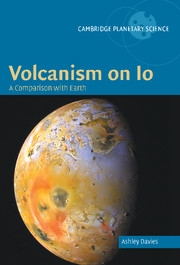Book contents
- Frontmatter
- Contents
- Preface
- List of Abbreviations
- Reproduction Permissions
- Introduction
- Section 1 Io, 1610 to 1995: Galileo to Galileo
- Section 2 Planetary volcanism: evolution and composition
- 4 Io and Earth: formation, evolution, and interior structure
- 5 Magmas and volatiles
- Section 3 Observing and modeling volcanic activity
- Section 4 Galileo at Io: the volcanic bestiary
- Section 5 Volcanism on Io: the global view
- Section 6 Io after Galileo
- Appendix 1 Io hot-spot locations
- Appendix 2 Io maps
- References
- Index
- Plate Section
5 - Magmas and volatiles
Published online by Cambridge University Press: 05 October 2014
- Frontmatter
- Contents
- Preface
- List of Abbreviations
- Reproduction Permissions
- Introduction
- Section 1 Io, 1610 to 1995: Galileo to Galileo
- Section 2 Planetary volcanism: evolution and composition
- 4 Io and Earth: formation, evolution, and interior structure
- 5 Magmas and volatiles
- Section 3 Observing and modeling volcanic activity
- Section 4 Galileo at Io: the volcanic bestiary
- Section 5 Volcanism on Io: the global view
- Section 6 Io after Galileo
- Appendix 1 Io hot-spot locations
- Appendix 2 Io maps
- References
- Index
- Plate Section
Summary
The surface of Io is covered in sulphur dioxide (SO2), sulphur, and silicates. Based on images of lava flows, estimates of lava eruption temperatures, and observed topography, silicate flows are common. The absence of steep-sloped (>10°) volcanic edifices (e.g., Clow and Carr, 1980; Schenk et al., 2004) suggests that lavas are fluid and of low viscosity, which indicates they are low in silica and therefore more akin to basalt or ultramafic composition lavas than silica-rich, high-viscosity lavas such as terrestrial rhyolite and dacite.
Volcanogenic elemental sulphur forms deposits on the surface of Earth and Io. Secondary sulphur flows, comprised of re-mobilized deposits of volcanogenic sulphur, are found on Earth and are probably quite common on Io as well.
SO2 dissolves in silicate and sulphur magma under sufficient pressure. It is a common volatile in terrestrial magma and is ubiquitous on the surface of Io (Carlson et al., 1997). SO2 plays an important part in Io's volcanism, driving most plume activity. SO2 in the lithosphere and on the surface of Io is readily mobilized by contact with hot silicates and sulphur.
This chapter reviews the physical and thermodynamic properties of these materials and their role in Io's volcanism. The first part of the chapter considers silicate magmas. The second considers sulphur and sulphur dioxide.
- Type
- Chapter
- Information
- Volcanism on IoA Comparison with Earth, pp. 73 - 90Publisher: Cambridge University PressPrint publication year: 2007

